With the advent of streaming and video-on-demand (VOD), more and more people are choosing to stay home to watch a movie. But for a home theater to deliver a visual experience close to the dark rooms, you need to buy a quality TV. 4K, 8K, LG, Samsung or Sony, you will find in this guide the best TVs for home cinema of the moment.
Here is our commitment, to make sure that we provide the best user experience and content quality:
You can support us by using our links to make your purchases (at no extra cost to you)! This sometimes earns us a commission which allows us to remain independent. More about us
Our selection
"With its QE65Q800T, Samsung makes 8K accessible to the masses. This TV will be perfect for a home theater setup, with sharp, bright images and…"
"The TCL C715 is a good 4K TV for home theater, with enticing specifications. We like its pleasant QLED panel, with vivid colors, and Dolby…"
"Despite the palpable lack of 8K content and pricing positioning far from being within the reach of most people, the Samsung Q950TS 8K QLED TV…"
"The LG OLED55CX6 offers new features to enhance the gaming and movie watching experience. Offering excellent 4K images, it improves scaling and motion reproductions."
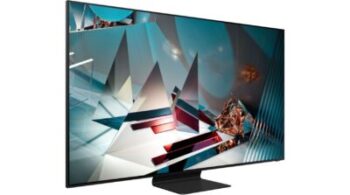
With its QE65Q800T, Samsung makes 8K accessible to the masses. This TV will be perfect for a home theater setup, with sharp, bright images and incredibly detailed sound.
See the priceThe Samsung QE65Q800T is a 65-inch 8K TV. To keep the price down, Samsung had to make some concessions. Starting with the absence of an external connection box, normally seen on the high-end TVs of the South Korean giant. Its connections are all integrated from the main chassis.
The Samsung QE65Q800T also uses a backlight system that is quite reduced compared to the one found in the Samsung Q950TS range. It's still a FALD panel, but it only delivers 224 independent dimming zones, compared to 480 on the QE75Q950TS, Samsung's flagship high-end 8K TV.
In terms of specifics, this 8K TV still benefits from the brand's own power management. This improves contrast by more intelligently distributing how power is projected onto the screen, borrowing from the dark areas of the picture and redirecting to the bright areas. It also takes advantage of Samsung's latest Quantum 8K processor, with enhanced scaling of sub-8K content. Finally, the QLED panel benefits from Samsung Quantum Dot colors with support for HDR10 and HDR10+ formats.

The TCL C715 is a good 4K TV for home theater, with enticing specifications. We like its pleasant QLED panel, with vivid colors, and Dolby Vision sound. But the black uniformity is not excellent.
519 £ on BoulangerWhile QLED TVs have been expensive so far, the latest advances from Samsung and OnePlus have made the technology more affordable. TCL is following the trend with the C715 series. In that sense, the TCL 55C715 offers 4K resolution in a 55-inch screen. The set looks great thanks to a metal frame around the screen and the thin borders. The TV is also well equipped, with 3 HDMI ports, 2 USB ports, 1 LAN port, 1 antenna jack, 1 digital audio output (optical), 1 single AV-In jack and 1 3.5 jack audio output for headphones or speakers.
Despite some misfires at launch time regarding the software, the TV makes up for this with excellent performance. The benefits of the QLED display are immediately apparent, and the TV delivers a decent, full viewing experience with all kinds of content, even in the lower resolutions (720p and 1080p). The TV's performance on native 4K HDR10 or Dolby Vision content is quite impressive at this price.
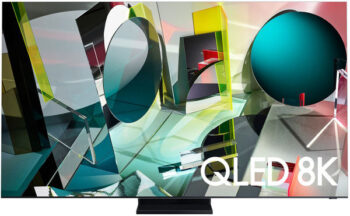
Despite the palpable lack of 8K content and pricing positioning far from being within the reach of most people, the Samsung Q950TS 8K QLED TV offers a demonstration of what our future home theaters will look like.
6 399 £ on FnacHonestly, we've already seen everything in terms of design on a TV. As long as the screen is big and there are not too many borders, it's fine. And in the case of the QE85Q950TS, Samsung has hit the nail on the head. The screen is very large, not to say huge, with its diagonal of 85 inches. Samsung has also managed to wrap the QLED panel with a very thin border, only 2 mm! The 15 mm depth of the chassis is also impressive. All the connections, namely the 4 HDMI ports, 3 USB ports, RF and satellite antenna inputs, and the Ethernet port, are contained in the external One Connect box.
The configuration menu governing the image quality shows the total. It's neither difficult nor tedious to fine-tune the settings to your preferences. The lack of native 8K content means that this display will spend most of its time scaling lower resolution content to fit its powerful native 7680 x 4320 resolution. This is possible thanks to the AI and machine learning efforts of the software that comes with the Samsung QE85Q950TS. The display can then cross-reference the composition of the image with its massive information base. The clarity and accuracy of this scaling both amazes and detracts.
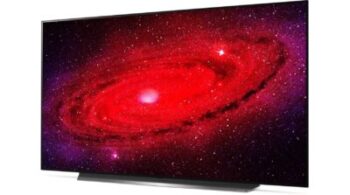
The LG OLED55CX6 offers new features to enhance the gaming and movie watching experience. Offering excellent 4K images, it improves scaling and motion reproductions.
1 112 £ on BoulangerThe LG OLED55CX6 is a well-designed and stylish 55-inch TV. At the back is the usual assortment of connections: optical output, Ethernet port, inputs for satellite and terrestrial antennas, 2 USB and 1 HDMI 2.1 connection. The side connections include the other HDMI 2.1 connections, 1 USB port and 1 CI (Common Interface) slot. This TV supports HDR10, Broadcast HLG and Dolby Vision.
Picture quality, color reproduction, viewing angles, motion clarity and contrast are top-notch thanks to the OLED panel used, which is an ideal choice for HDR content. Among the most interesting features of the LG OLED55CX6 we will mention the Cineaste mode and Dolby Vision IQ. In addition, the LG OLED55CX6 has all the qualities we loved about its predecessor, the LG C9, including extremely low input lag, measured at ~ 13 ms at 60 Hz and ~ 6 ms at 120 Hz. HDMI 2.1 compatibility allows this TV to run 4K games at 120 fps using a single cable on PlayStation 5, Xbox Series X and next-generation PCs.
Any specific needs?
The best TV for home theater in 2021
The best TV for entry-level home theater
The best TV for high-end home theater
Your guide :
Rate this buying guide :By rating this buying guide, you are helping us to reward our best writers. Thank you!
| TOP OF THE LINE | CHEAP | TOP OF THE LINE | EXCELLENT | |

In accordance with our commitment, this buying guide does not contain any sponsored products. |
 9/10 |
 7/10 |
 9/10 |
 9/10 |
| OUR SELECTION |
Samsung QE65Q800T
|
TCL 55C715
|
Samsung QE85Q950TS
|
LG OLED 55CX6
|
|
With its QE65Q800T, Samsung makes 8K accessible to the masses. This TV will be perfect for a home theater setup, with sharp, bright images and incredibly detailed sound.
|
The TCL C715 is a good 4K TV for home theater, with enticing specifications. We like its pleasant QLED panel, with vivid colors, and Dolby Vision sound. But the black uniformity is not excellent.
|
Despite the palpable lack of 8K content and pricing positioning far from being within the reach of most people, the Samsung Q950TS 8K QLED TV offers a demonstration of what our future home theaters will look like.
|
The LG OLED55CX6 offers new features to enhance the gaming and movie watching experience. Offering excellent 4K images, it improves scaling and motion reproductions.
|
|
|
Screen size
|
65"
|
55"
|
85"
|
55-inch
|
|
Native resolution
|
8K (7680 x 4320 pixels)
|
4K (3840 x 2160 pixels)
|
8K (7680 x 4320 pixels)
|
4K (3840 x 2160 pixels)
|
|
HDR supported
|
HDR10, HDR10+
|
HDR10, Dolby Vision
|
HDR10, HDR10+
|
HDR10, Dolby Vision
|
|
Native refresh rate
|
100 Hz
|
50 Hz
|
100 Hz
|
100 Hz
|
|
Sound processing
|
Dolby Digital Plus
|
Dolby Atmos
|
Dolby Digital Plus
|
Dolby Atmos
|
Help us improve this table:
Report an error, request the addition of a feature to the table, or suggest another product. Thank you for your kindness!
We spend thousands of hours each year studying the major specialized websites, analyzing products of hundreds of brands and reading user feedback to advise you on the best products.
We are a product review company with a single mission: to simplify your buying decisions. Our research and testing helps millions of people every year find the best products for their personal needs and budget.
To support us you can: use our links to make your purchases (which often earns us a small commission), share our articles on social networks, or recommend our site on your blog. Thanks in advance for your support!

To watch a movie like you would in a theater, you need a huge screen. Think about where you're going to place your new TV and how many people will be using it. Choose the largest screen size that your budget allows and that will fit in your TV area. The best value screen sizes are between 55 and 65 inches. Viewing distance is also a major consideration when determining screen size. As a rule of thumb, you should sit at a distance no more than twice the diagonal of the screen.
Simply put, resolution refers to the sharpness of the image projected by the TV. It is usually described in terms of horizontal lines of pixels. A budget HDTV can produce only 720p, which means that the TV displays 720 scanned lines in a single pass or incrementally. The standard for HDTVs today is Full HD 1080p, which has 1080 lines of resolution. Text is sharper and images are more detailed and realistic. This should also be the minimum resolution to consider when buying a new TV for home theater. We recommend that you avoid 720p models.
The refresh rate describes how many times per second an image is refreshed on the screen. Expressed in Hertz (Hz), the standard refresh rate is 60 Hz. Unfortunately, a 60 Hz refresh rate may not be sufficient in scenes with fast-moving objects or bodies and will create blurry images. This is a problem that is mainly encountered on TVs with LCD panels. To create a better picture quality, manufacturers have often doubled the refresh rate to 120 Hz and, in some cases, increased the refresh rate to 240 Hz. Also, beware of terms like "effective refresh rate". This means that the actual refresh rate is actually half the stated refresh rate. For example, an effective refresh rate of 120 Hz actually means an actual refresh rate of 60 Hz.
HDR or High Dynamic Range is a feature found only on 4K TVs. HDR refers to the ability to provide increased brightness, more contrast levels and more color. HDR is not available on HD (720p) and Full HD (1080p) TVs. Dozens of TV manufacturers are now adopting HDR as a basic minimum specification. So to distinguish them from standard 4K TVs, manufacturers are creating new names for TVs with HDR functionality. For example, if you see a TV with the term Ultra HD Premium, it supports HDR. The term "Dolby Vision" is also becoming more widely used. This is a more demanding version of HDR. A Dolby Vision set, in theory, must meet a more stringent set of criteria to display HDR content. On the other hand, you should know that at the moment there is very little content that really exploits the HDR functionality.
Black uniformity refers to a TV's ability to display solid black across its screen. If a TV has poor black uniformity , some parts of the picture will be lighter than they should be, which can ruin the effect of a scene. The lighting on the TV should be perfectly diffused on the screen. Lighting in movies is set up for a specific artistic purpose. A TV with great black uniformity will have fewer lighting problems.
One of the most overlooked features when buying a new TV is the sound quality. It is extremely annoying to have music or background noise drown out the dialogue of the actors. Even the most expensive 4K TVs can have an Achilles heel of poor sound quality. This is a result of the trend toward slimming down TV manufacturers. There simply isn't enough room for larger speakers capable of producing rich, full sound. We suggest you look for a TV with a thicker frame size or a separate rear woofer. Sound bars are also very popular, as they can produce a more satisfying movie audio experience. For the more cinephile among you, we suggest you choose a separate audio system to get the ultimate sound experience.
Samsung's QLED and LG's Nano Cell are different marketing names attributed to their integration of Quantum Dot technology. LED LCDs use a white backlight to reproduce the image. It is not perfectly white and has traces of color impurities, which makes it impossible to reproduce colors accurately as well as a wider range of colors.
A Quantum Dot panel will replace the white backlight with a blue backlight and add a plastic sheet containing uniformly sized nanoparticles that glow red and green when excited by the blue backlight. This provides a purer white light and improves the color gamut, accuracy, and saturation of LCD TVs.
However, it still does not solve existing problems such as poor response times (motion blur), viewing angles, contrast, black levels and more that plague LCDs.
There are two main types of TVs for home theater today: OLED TVs and LED LCD TVs. Among modern HDTVs, there are no more traditional LCD TVs with CCFL backlighting. They have been replaced by LED LCD TVs. Let's take a closer look.
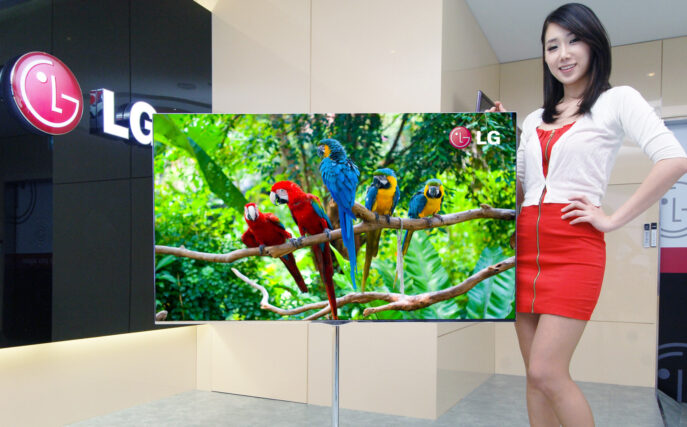
OLED stands for "Organic Light-Emitting Diode" or "Diode électroluminescente organique". It is a display technology that consists of placing a carbon-based film between two conductors that pass a current and allow the film to emit light.
Most importantly, this light is emitted pixel by pixel, so that a bright white or colored pixel can appear next to a black pixel or an entirely different color, without any impact on the other. This leads to truly exceptional contrast levels that none of the other TV technologies currently available can match because of their reliance on backlighting.
And because OLED TVs don't rely on a backlight to increase thickness, they can be thinner and lighter than most other TVs. Viewing angles also tend to be more or less perfect and response times can be extremely fast.
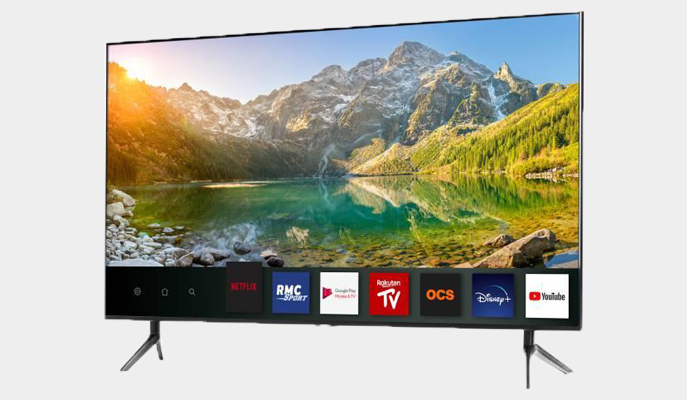
LED is not really a display technology in its own right. The light-emitting diodes in an LED TV actually provide the backlighting for an LCD panel, so an LED TV is actually an LCD TV.
As manufacturers began to move away from CCFL (cold cathode fluorescent lamp) backlights and began to introduce LED backlighting, they ramped up the marketing and convinced everyone that they should simply upgrade their LCD TV to an LED TV, even though both panels are composed of an LCD panel. It was the light projection technology that simply changed.
But just because the marketing was a bit misleading doesn't mean the technology isn't worth it. Compared to an older CCFL backlight, an LED backlight can generally become brighter, provide better contrast, improve energy efficiency and reduce the weight and thickness of a TV.
Depending on the type of panel used, the viewing angles of a flat screen TV will be different. Flat screen TVs with an IPS panel have better viewing angles than TVs with a VA panel. OLED flat screen TVs, on the other hand, lose none of their picture quality when viewed from different angles. Glare isn't a big problem for flat panel TVs either, unless you have a screen with a glossy coating.
A flat-screen TV blends in easily, mainly because of its straight lines. Especially since all the other devices in your living room have relatively straight lines (game console, audio system, Blu-Ray player, etc.). The flat design is especially nice if you mount your TV on the wall.
Finally, it's worth noting that if you opt for a flat-screen TV, you'll have plenty of choice. Flat screen TVs come in all sizes, shapes and resolutions. Plus, you'll find a model that's right for you, no matter what your budget.
To put it simply, the viewing experience you get with a curved screen is not much different from what you are used to with a flat screen. On the other hand, it will be much more immersive only if you stand right in front of the screen. This is because the picture quality deteriorates more quickly if you move away from the ideal viewing angle of -35 to +35°. In addition, a curved TV extends reflections.
Since everyone is used to seeing a flat screen, the design of a curved screen TV is bound to attract attention. So if you want a TV that stands out and produces a "WoW" effect, you should go for a curved TV.
You won't have many options when choosing a curved screen TV. Moreover, this type of TV is always positioned at the top of the range. So if you have a limited budget, you simply won't be able to afford a curved screen.
Both the flat screen TV and the curved screen TV offer stunning, lifelike picture quality. But you may like the immersive experience of the curved screen or the interior design versatility of the flat screen. It all depends on what you like to watch, how you like to watch it and how you want your living room design to look. Finally, the budget you have for the purchase is also an important consideration.
Opt for more HDMI connections
This may seem like an afterthought, but count the number of devices you want to connect to your TV. Make sure the TV you want to buy has at least as many HDMI ports as the devices you have at home (Blu-Ray players, game consoles, etc.). Make sure the display comes with at least four HDMI ports with HDCP 2.2 DRM compatibility and at least HDMI 2.0 support. However, it is best to purchase a TV that supports HDMI 2.1 to prepare for the future.
Position the TV properly
It's
imperative that your TV's position is perfect. It should ideally be at eye level, and a wall mount is best to save the space that a wall unit can take up. Even if you have a model that can be wall-mounted, you can make its location match your eye level when you are sitting on the couch.
Go for a Smart TV
More and more televisions today have Wi-Fi connectivity and incorporate different. Even if you choose an entry-level model, it's increasingly difficult to find a TV that isn't "Smart."
Choose a display that supports high refresh rates
You
don't just use your new TV to watch movies or series. So if you also plan to connect a gaming console or PC to your home theater setup, be sure to choose a display that supports high refresh rates of 120 Hz and higher. The upcoming PlayStation 5 and Xbox One Series X consoles will support high refresh rates of up to 120 Hz, while all current PC games support refresh rates of 240 Hz and higher.
Projectors are a credible alternative
If
you want an even bigger screen to enjoy your movies and other audiovisual content, you can choose to purchase a projector. There are different types of projectors, but if you have a big white wall and a rather large living room, a projector is a great alternative to a 4K or 8K TV, especially in terms of price.
The best TV for home cinema depends on your needs and your budget. Read our buying guide to find out which products are the best.
Quantum dots are another LCD technology that is becoming more common. Basically, an LCD TV that uses quantum dots has another layer of nanocrystal dots of different sizes that light up when the LED backlight hits them. The result is increased brightness and a wider color spectrum . Samsung recently launched a line of Quantum dot SUHD TVs with true-to-life picture quality.
This term describes the active dimming of LEDs at particular positions to give a deeper black, thereby increasing contrast. This technology is only available on Full HD (1080p) LED TVs. In addition, it would be better to select a full matrix backlit LED TV than an edge lit LED variant.
Some people love 3D movies, others hate them. This option will only be relevant to your personal preferences. Note that a TV capable of displaying 3D images can also reproduce standard 2D content. To view 3D content, you will need 3D glasses and, most importantly, a 3D Blu-Ray player.
The viewing angle is a vital specification for placing a TV in a room where some of the seating may be off-center. If the TV you're interested in doesn't provide viewing angle information, check user reviews online or go see the TV in person at a local store. The color and light levels of a TV can fade when viewed from a certain angle.
Every month we help more than 1 000 000 people buy better and smarter.
Copyright © 2022 - Made with ♥ by buyingbetter.co.uk
Your reviews and buying guides 0% advertising, 100% independent!